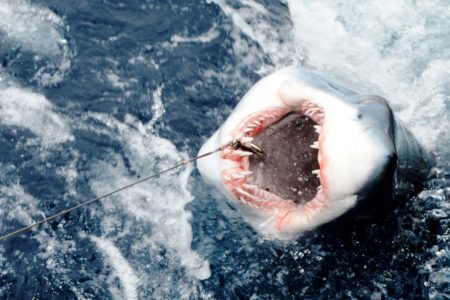Shark fishing provides a fun and exciting change of pace for family fishing fun.
Tired of taking the family bottom fishing only to have the kids want to go back early? Well, there is a great solution that needs very little to get into and pays back in huge smiles and excitement: tangling with inshore sharks. With a bit of caution, it can be the safest fishing there is! To begin with kids are innately interested in sharks. They have a fear, but an interest as well. Our job is to fan the interest and let that overcome the fear. Need more convincing? First, no need to leave early. These fish feed all day (a tad better at dusk), so a later, or even afternoon departure is perfect! Secondly, spots will be three miles or less offshore, and in some cases even in the bay, so no need for long runs. And lastly, inshore sharks are somewhat smaller, and as anglers we can even choose to fish for smaller sharks to bolster the interest and keep that fear at bay.

There is generally no need for a long run to the grounds, and in fact you will often never lose sight of land. Finding a spot to fish inshore sharks is about as simple as finding some structure. Any bump, hole or change in bottom contour or wreck/reef will hold fish. Look at your charts or chart plotter and identify some likely changes in bottom. Keep in mind that 25 feet is certainly NOT too shallow to hold fish. Artificial reefs are like buffets to sharks, so they are perfect places to start. As a rule, you can drift the reefs for sharks, but if you’re fishing holes or bumps you should anchor to stay on the productive spot.
Once a location has been reached, the first step is to deploy a chum slick. This is accomplished using a 4- to 5-gallon bucket of bunker chum. These can be purchased at any bait and tackle shop. Once on the grounds, the chum can be put in a chum bag, or with the lid removed can be inverted in a milk crate and simply tied with rope to a cleat. Either way, the frozen chum will thaw and attract sharks to the baits. Speaking of baits, bunker is king here. Fresh is best as always, but in a pinch frozen will work. What is also worth noting is that many days bunker schools will pass the boat, so have a snag rig ready to get fresh live bait. A simple chunk of bunker will work as hook baits.
Most anglers who want to try this already own the gear they need. Any 15- to 20-pound class setup will work here. Your favorite striper live-lining combo, your tolling combo (minus the wire line), and even your small tuna setups all work here. No need for 50-class anything, remember you want kids to enjoy so use as light as you feel comfortable.
Take 3 feet of single strand wire (75#) and using a haywire twist, attach a barrel swivel to one end, and an 11/0-16/0 non-offset circle hook to the other end. It is law that only non-offset circle hooks are used when fishing sharks.
Most of the smaller inshore sharks will feed in the water column. Baits need to be suspended above the bottom using some type of float. I prefer either Redi-Rig floats, or Fisher King balloon clips. These products allow you to retrieve the float and not set it adrift to pollute the environment. A typical four-rod spread would consist of baits and floats set to cover the entire water column including one bait on the bottom. The floats can be watched by the kids, and of course the reels are set with clickers on and with light drags if possible.
When a fish picks up a bait, grab the rod, count to 15 and then reel until the line comes tight. Then just lift the rod tip and the fight is on! As the fish begins to get closer to the boat, it’s time for the adult to be ready. Sharks are a resource in danger, so release all the fish that are caught. Once the fish is reeled to the swivel, take some pictures, but please, be cautious here. We are all used to social distancing, and never have those rules been more applicable than at this moment; remind the kids to look but not touch. Then using a pair of long-handled wire cutters, simply cut the leader and release the fish. Unlike offshore sharking, this type of sharking can have multiple fish in a single trip. Once boat side, you can ID the shark with this handy dandy shark id page that you can print right at home from https://www.thefisherman.com/index.cfm?fuseaction=feature.display&feature_ID=1438&ParentCat=2.
As mentioned in the previous paragraph, all sharks should be released. However, there are a few federally protected shark species that you may run across in your fishing. The sandbar shark (brown shark), the dusky, and the sand tiger are all protected, and you may not possess them. Others, such as hammerheads (yes there are a lot here), Atlantic sharp-nosed, spinner and blacktip sharks are not protected but should be released as well. Again, sharks are a resource in trouble so admire them, enjoy the fight, but cut them free! Lastly, you will need a HMS (highly migratory species) permit. You can get them online at https://hmspermits.noaa.gov/, and be sure to watch the video and get the shark endorsement.
This summer, make the kids’ season and take ‘em to experience sharks; you know you want to as well!


